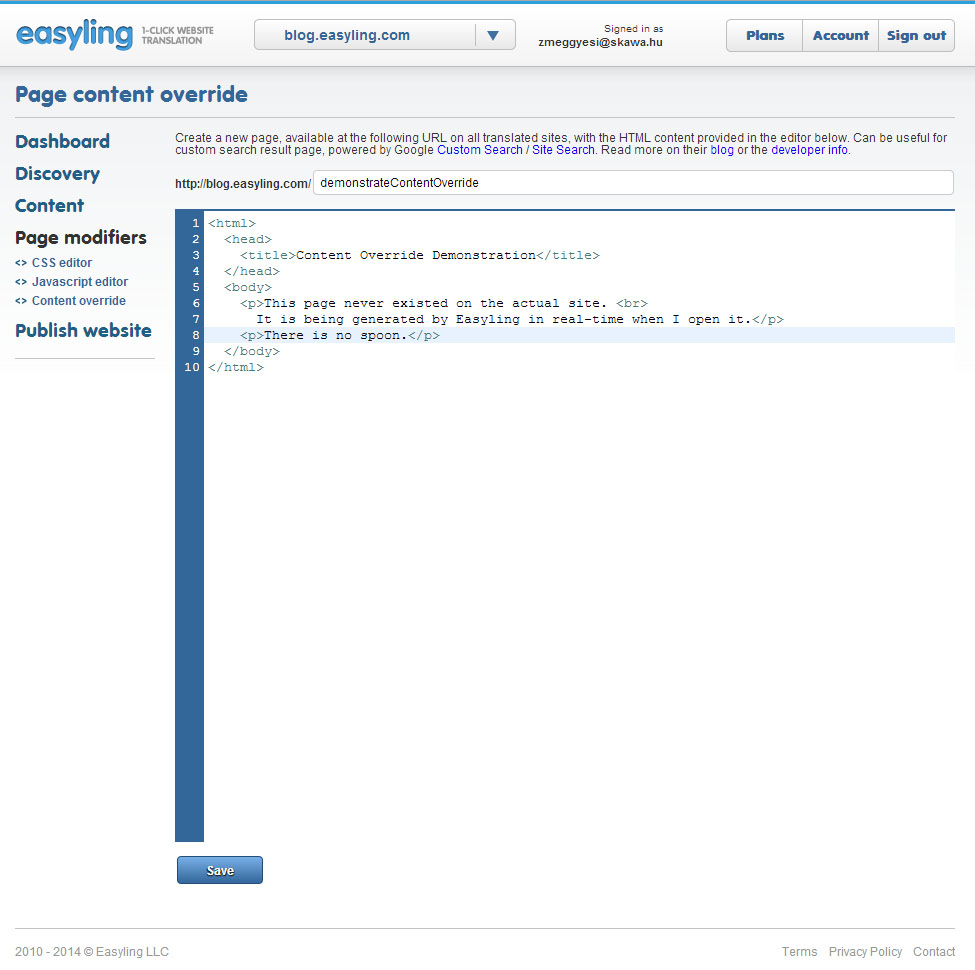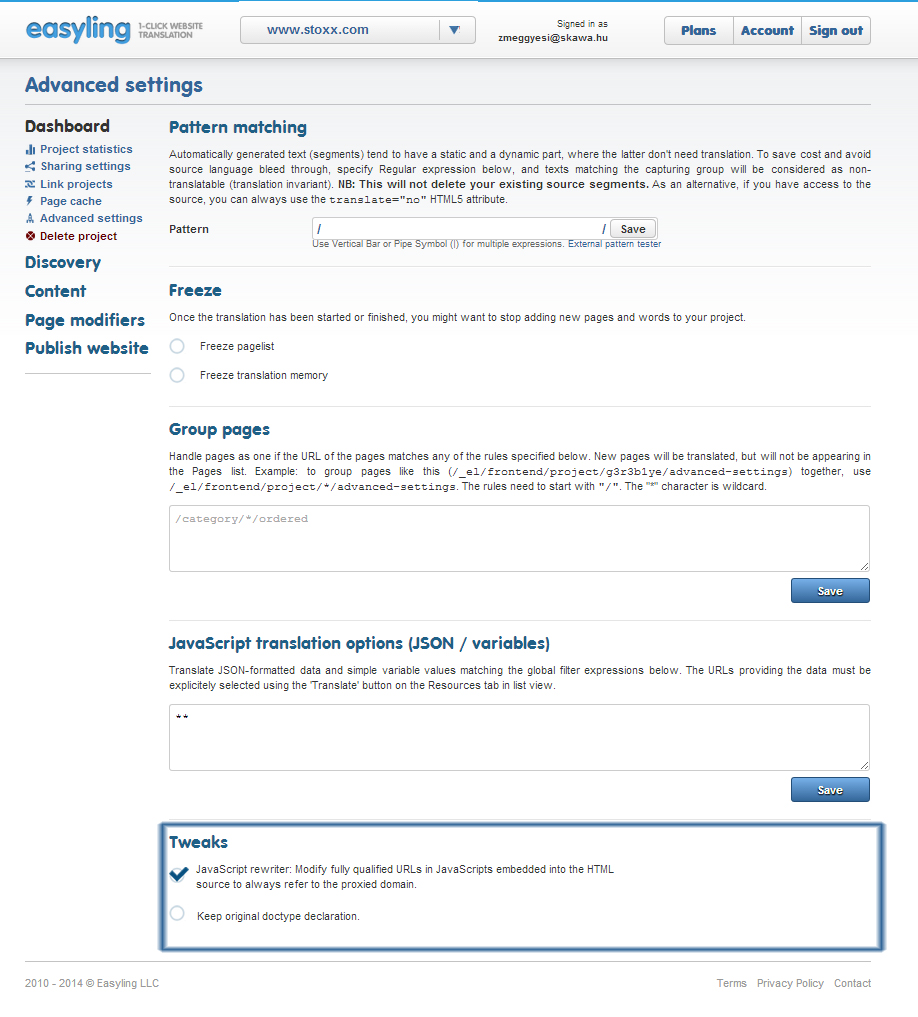Easyling Release Notes - April 2014
This post has not been updated in a long time. The information may be out of date.
Now that April has ended, Easyling has gained a few new capabilities, expanding usability even further. We can now create new pages not existing at the original site, group URLs to stop spawning page entries for WebApps, pseudo-translate websites to test if all the content is picked up, translate JSON objects in AJAX calls and JavaScript files, and we also some Advanced Settings to tweak the site’s behavior.
Content Override: Easyling can now create a single page on the site from scratch, or even override the selected page’s content with custom HTML specified by the user. This feature provides a fully featured HTML editor, and allows the user to enter the code for a complete page, along with a URL, which will “host” this page. The “virtual” page is then made available on the selected URL (overriding any page already there), ready for translation, should it be needed. The most usual use for this is creating a localizable search page: the user would copy the source of an empty page template, adding, say, a Google Site Search element, which would be able to search the translated site, instead of the original.
[caption id=“attachment_1046” align=“aligncenter” width=“975”] New ‘virtual’ pages may be created from scratch, or existing ones overridden by entering the HTML code.[/caption]
New ‘virtual’ pages may be created from scratch, or existing ones overridden by entering the HTML code.[/caption]
Group Pages: sometimes pages should be handled in bundles. Such is the case for web applications and webshops, where many pages are just variations of the same item, or the order confirmation pages are on unique, parametrically generated URLs, but have the same content. In such cases, specifying a filter expression matching the URL mask of the pages will instruct Easyling to treat them as belonging together, and sharing the same dictionary. This will also cause only the first instance to be shown in the page list, avoiding further unnecessary clutter.
[caption id=“attachment_1058” align=“aligncenter” width=“918”] Pages can now be grouped based on their path, in order to reduce clutter in the page list.[/caption]
Pages can now be grouped based on their path, in order to reduce clutter in the page list.[/caption]
X-Proxy: the first step in translating sites is often a pseudo-translation, where the text of the site is replaced with machine-generated content or meaningless text to see which parts of the site will be translated. This could be done in Easyling, using pseudo-translation, or in an external CAT-tool, necessitating an export-import, both of which use up your resources. But now, simply Shift-clicking the Preview button will take you to the X-Proxy, which replaces all text with X-s (of the appropriate case), cutting out the previous export-import steps and the use of an external CAT-tool. This will allow you to see which parts of the page will be picked up for translation, and which parts may cause problems, such as JavaScript-generated areas, iFrames drawing from other domains, and similar parts of the page which are “hidden” from the translation proxy.
[caption id=“attachment_1045” align=“aligncenter” width=“1903”] Pseudo-translation can become a thing of the past with the X-proxy mode, which displays a pseudo-translated page with the click of a button, and doesn’t use resources.[/caption]
Pseudo-translation can become a thing of the past with the X-proxy mode, which displays a pseudo-translated page with the click of a button, and doesn’t use resources.[/caption]
JavaScript_ translation_: Easyling is able to process JSON objects in JavaScript files and AJAX calls, and treat them like regular translatable pages. To do this, you need to mark the requisite JavaScript files as translatable, then edit the global JSON filter expression, which allows Easyling to extract and translate content with the matching keys only.
[caption id=“attachment_1059” align=“aligncenter” width=“918”] JavaScript files can be translated as well, but beware of changing values used in program logic later on![/caption]
JavaScript files can be translated as well, but beware of changing values used in program logic later on![/caption]
DOCTYPE retention: some pages may rely on specific standards related to layout rules, which may have changed over time. When these rules are determined by the page’s DOCTYPE attribute, Easyling can be instructed to forgo our convention of serving HTML5-compliant pages, and retain the original DOCTYPE attribute. This feature is available in the new ‘Tweaks’ area of our Advanced settings menu.
[caption id=“attachment_1060” align=“aligncenter” width=“918”] One of the new tweaks is the ability to retain the default DOCTYPE attribute if the site for example shows problems in HTML5.[/caption]
One of the new tweaks is the ability to retain the default DOCTYPE attribute if the site for example shows problems in HTML5.[/caption]
Caching: Easyling now has a new version of the cache, called the Keep Cache. By caching the most translated state of the page, and serving that, not only are site load times improved drastically, but the Bleeding Effect is also eliminated: any new content will simply not be served until it is translated, but new translations are pushed through automagically.
[caption id=“attachment_1068” align=“aligncenter” width=“966”] The Keep cache eliminates source language bleed-through by withholding new content until it is translated, but translations are still published in real-time.[/caption]
The Keep cache eliminates source language bleed-through by withholding new content until it is translated, but translations are still published in real-time.[/caption]
Last week, we also gave a presentation at the Budapest2014 conference for freelance translators on website localization. Here’s a video from the event:
We also attended the MemoQFest, and we’ll soon be heading to Palm Springs for ALC2014. Expect a report soon after!
How can we assist you?
We are happy to help with your questions and concerns about your website localization project.
Book a 30-minutes consultancy meeting with our experts and ask your questions!